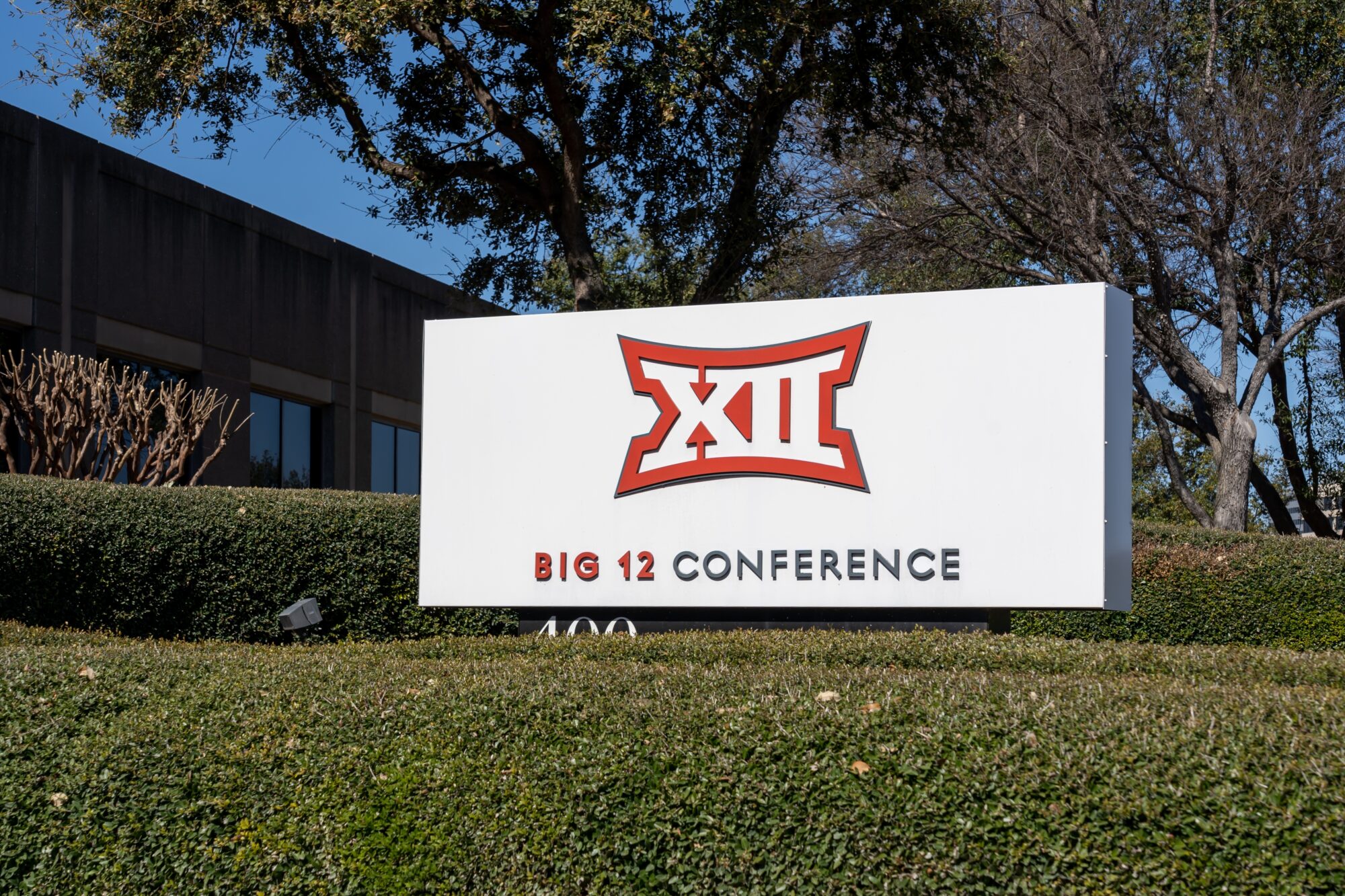
BY JEFF FULLER
What a difference a year makes. The Big 12 Conference was hanging by a thread after Oklahoma and Texas announced they were SEC-bound in late summer 2021. The remaining eight schools scrambled to dust off their resumes and find potential lifelines from the Big10, SEC, ACC, and PAC12, only to be rebuffed by all. Their own commissioner at the time, Bob Bowlsby, testified before Texas lawmakers that losing these two “Blue Blood” programs would cut the media value of the remaining Big12 in half. This meant that the Average Annual Value (AAV) of the current media deal would drop from $22 million per team per year, to a paltry $11M.
Stewart Mandel confirmed that 50% loss figure and calculated that the remaining eight Big12 schools were actually only worth $7M-$12M in AAV. He shared this dire warning at the time, suggesting a merger with the AAC (yes you read that right, AAC, not ACC):
“Two sports TV consultants estimated to The Athletic that about 50 percent of those deals’ value was derived solely because of Texas and Oklahoma. …
Unfortunately, that $7 million-to-$12 million range does not bode well for the Left-Behind 8’s chances of landing an invitation to one of the other Power 5 conferences. The ACC, Big Ten and Pac-12 are unlikely to invite a school that would drag down its current members’ slice of the conference pie.”
So, the “Irate 8” are being told they’re not valuable and that nobody wants them. Pretty depressing, right?
Could a “Hail Mary” of adding non-P5 conference programs like BYU, Cincinnati, Houston and UCF make up for the media value loss of behemoth programs like Texas and Oklahoma? Sounds crazy, right? Could BYU come into their new conference among the tops of current membership in media value? Stick around and find out…
Big 12 Media Deal Magic
Fast forward one year and the Big12, with newly-minted commissioner Brett Yormark, his aggressive, innovative, and disruptive style in-tow, announced they had reached a six-year $2.3 Billion deal with ESPN and Fox for an AAV of $380M, or $32M/team ($31.67M to be exact) as reported by Pete Thamel:
“The overall value of the Big 12’s media deal is expected to increase from $220 million annually to $380 million. That’s an average increase in media-only revenue per school from $22 million to $31.7 million (the $380 million is now divided 12 ways with the addition of BYU, UCF, Cincinnati and Houston).”
How in the world was this accomplished? You lose half of your media value in OU/UT and somehow end up with a deal paying nearly 50% more in AAV than your current deal? You were told you should only expect $7-$11M and you end up with 3-4 times that much? Is Yormark a magician or something?
While shrewd negotiating surely helped, there are many other factors that boosted the Big12’s bottom line:
- Timing:
- Any new media deal should beat the last deal done due simply to market dynamics and inflation. There is a long and strong precedent here.
- The Big12 got to jump into the relative vacuum in midwestern ESPN content created by the Big Ten’s new deal no longer including that long standing partnership. The PAC had plenty of content to offer up as well, but not easily in the lost TV windows where Eastern and Central Time zones teams play. Advantage Yormark.
- A good combination of football relevance and parity in the Big12–
- previously under-valued brands reached greater relevance; like Kansas football garnering enough attention to host College GameDay vs TCU
- four different teams made the Big12 championship game in the last two years, none of which were future defectors OU or Texas
- Twelve of the 14 teams, including all four newcomers, were ranked in the AP poll at some point during the last football season (lacking only Iowa State, who spent much of the two previous years in the top10, and Texas Tech, who surged to an 8-5 record last year, including a bowl win and finishing in the final AP Poll’s “Others receiving votes” category.)
- Engaged and passionate fans who show up to games and provide great atmospheres for TV broadcasts
- Elite basketball which is the nation’s best
But there’s one media-value-boosting factor that probably hasn’t received as much attention as it should: the media value of the Big12’s new additions, BYU, Cincinnati, Houston, and UCF. If Bowlsby and Mandel were correct, that losing the Sooners and Longhorns was losing 50% of the Big12’s media value, where does all this extra media value come from? There’s a strong case to be made that much, if not most, of this new media value was garnered through the strategic wisdom of taking the clear four best expansion candidates on the market.
Media Value of BYU, Cincinnati, Houston and UCF
Clearly, part of this increased value comes from the expanded content that having more teams provides; there are simply more intriguing matchups for media partners to choose from. Additionally, these four schools brought the average living alumni figure per Big12 school from 200,000 up to 250,000 (25% gain), and the average number of undergraduates enrolled from 20,000 up to 27,000 (35% increase.) It’s clear that the Big12 valued large enrollment schools when expanding due to the associated larger (potentially) fan bases.
Each of the new schools brings significant value to the equation in other ways as well:
–Cincinnati brings a recent playoff appearance, an engaged fanbase, and a solid TV market that is passionate about both college football and basketball.
–Houston has a solid football program, nationally elite basketball, a growing fan base, surging enrollment, and is located in the nation’s 7th largest media market.
–UCF is truly a sleeping giant with the nation’s 2nd largest total enrollment at 72,000 students. They are also among the nation’s most engaged fans on social media. The Knights are located in a rapidly expanding media market (17th largest) and in a state that “loves them some college football.” Personally, I wouldn’t be surprised if UCF was in new Big12’s top 4 for media value.
BYU, however, provides the most clear evidence of a true “value add” for the Big12, quickly becoming a key cog of the Big12’s new media deal. And that’s not just the “BYU homer” in me speaking; unbiased sports media professionals have confirmed BYU’s value. Stewart Mandel, observing the PAC struggling to get a media deal done, recently opined:
“The one school the Pac-12 could have added anytime in the last 40 years that would have absolutely created value is BYU. But generation after generation of the league’s presidents made it clear they wanted nothing to do with a church-owned university”
That means that BYU would have been at least as valuable to the PAC as their average school, which was expected to be around $45M AAV before the Big Ten stole away USC and UCLA. So, according to this thinking, BYU would have been worth over $45M AAV to the PAC in an upcoming deal despite the disadvantages of sharing the local TV market 50/50 with Utah. It then stands to reason that the Cougars would present even more value to the Big12, by bringing them into a new TV market, a new Time Zone, and an ability to air games in the latest TV time window..
Andy Staples and Max Olson, in August 2021 wrote an entire article in The Athletic about the media value BYU could bring to the Big12 (no invitation had yet been extended to the Cougars at that time), citing many things such as a strong fanbase, national brand, TV ratings, as well as opening a new late TV time slot for the Big12.
“adding BYU would allow the Big 12 to open a new TV window, a possibility that provides greater value in a media rights negotiation.”
Nicole Auerbach wrote the following in a separate piece in The Athletic piece (shortly after BYU received the official Big12 invite):
“Both sides also understood the national appeal of such a marriage. An industry source told The Athletic that BYU’s ESPN games generally garner bigger audiences than the remaining Big 12 schools in comparable windows and could increase their per-school TV revenue by about $2 million annually in the Big 12’s next deal.”
Going even further, Emmy-award-winning sports media professional, now-turned Forbes writer and consultant, Jim Williams, citing Big12 expanding by four teams as bringing value, stated in a SicEm365 interview:
“I don’t think [Bowlsby] gets enough credit… The money shot was BYU. And the reason the money shot was BYU is back in 2010 when the shift came, and again in 2015 and when we started getting people in, I had been involved in some of that in both times. ESPN was telling me, you know how much BYU is worth? BYU is probably the difference between $27-28 million and $31.6 million [per team, per year] in that contract.”
“So, BYU alone, was probably kicked into the $31.6 per team. So you’ve seen them go from $27 to $31 million [TV deal signed last fall]. So that was good on Bowlsby.”
He later gave more context on Twitter:
Bob what I said based on a conversation with a former ESPN executive was back in 2015 what would a BYU addition mean to a conference. He told me between 2 to 4 million in a contract depending on the conference. I should have qualified it by saying it wasn’t something I researched https://t.co/t4s66waLIw
— Jim Williams (@JWMediaDC) March 22, 2023
Calculating BYU’s value to the TV contract
So we’re dealing with multiple independent reports of BYU bringing an extra AAV somewhere in the $2-4M range. If we conservatively use $2.5M as the added AAV BYU contributes per team, we can subtract that amount from the $31.7M figure to get an $29.2M AAV that the Big12 would have received without adding BYU. Using these figures, we can use simple math to find BYU’s total value of $59.2M ($29.2M + $2.5Mx12 teams), or 16% of the Big12’s $380M/year total value—essentially a double share.
Some may question a staggering figure around $60M AAV for BYU. “Wasn’t ESPN only paying BYU around $10M/year up until now?” they (understandably) may say. A few points on this:
-
- The details of BYU’s Independent contracts with ESPN have never been publicly disclosed, so we don’t know most of the details, including that AAV figure, for sure.
- BYU has always valued exposure over revenue when it comes to media deals, and did attain unprecedented exposure in the ESPN contract.
- BYU launched into independence in the setting of their rival Utah (and later TCU) getting the call up to the big leagues; launching into the uncharted waters of Independence put the Cougars in a difficult “position of weakness” from a negotiating standpoint.
- BYU’s value to the Big12 is greater than it otherwise would have been in isolation due to opening up that late TV window for the whole conference.
- Many of the home schedules, especially late in the year, were against smaller brand programs and provided less TV value. This problem is now resolved and increased value is achieved by joining the Big12.
- The ESPN contract was only for the rights to 5 home football games per year with no road games nor basketball or other sporting events included
- Some suspect that part of the contract provided for ESPN to help find and broker games for BYU, but at a cost of decreased payout.
But, by far, the biggest reason BYU was “under-paid” by ESPN, relates to the risks any media partner must accept when entering a deal with an Independent.
Why Independent Media Contracts Pay Poorly
Notre Dame is unquestionably a top 5 football brand, but their current contract pays a paltry AAV of just $15M (although it’s backloaded, and so is actually paying out in the $22M-$25M range now.) If the Irish could only garner that figure with NBC, would BYU have any bargaining power to demand anywhere near or above that figure?
Although Notre Dame is expected to fetch around $60M AAV with their next media deal, this figure still doesn’t even match the Big Ten’s $75M AAV deal they inked last year, a conference that has been salivating for decades to have the Irish join due to the huge media value they’d bring.
Could anyone remotely believe that Notre Dame is worth LESS than the average Big Ten team? Additionally, the USC/UCLA departure was valued by former Fox Sports President, Bob Thompson, as taking their combined $200M AAV away from the PAC12 and giving it to the Big Ten (I recall some estimates splitting this as roughly $130M for USC and $70M for UCLA). So why is USC felt to be worth over double to Big Ten media partners than Notre Dame is worth as an Independent?
When dealing with Independent media contracts:
- Partners are only gaining the rights to the HOME games for Independent teams, and don’t get their valuable product for road games. In a conference contract, however, you get that team for all home games and for ALL conference road games.
- Media value is limited due to a lack of content options for media partners. If BYU or Notre Dame are having bad years and not very nationally relevant, their media partners are locked into airing those games anyways, and aren’t getting a very good return on investment.
- Conversely, when a deal is made with a whole conference, the content options skyrocket. The bigger the conference, the better the options are for media partners. Say Ole Miss is having a great year and about to host a top 10 LSU. That would likely be a game put on ABC that would garner 3-5M viewers. However, if #24 LSU goes to play a faltering 3-5 Ole Miss team, such a match-up might be relegated to ESPN or ESPN2 and have 2-4X fewer viewers. This scheduling flexibility is very valuable to media partners, and is something that Independent contracts simply can’t offer.
Conclusions
I will end this piece by taking a step back to look at the bigger picture. While BYU clearly brings added monetary value to the Big12’s media deal, that needs to be viewed from the “whole package” situation. BYU fans need to remember that we spent decades outside the “P5 Club,” that there are some challenges that BYU presents to the Big12, namely increased travel costs, and scheduling difficulties related to “no Sunday play.” The Big12, as a conference, enjoys revenue sports parity and engaged fans at all the schools, a lot of excellent programs, but no mega-brands nor major laggards. Every school appears to be able to “pull their own weight” more so than any P5 conference. While the lack of mega-brands may present some “low ceiling” challenges for the Big12, the “high floor” of well-balanced programs has allowed Brett Yormark to extract great value in the recently signed media deal.
After decades of pining for the validation that PAC12 admission would bring, it seems that the Big12 is in a safer and more profitable match for the Cougars. It is clearly a better “cultural fit” for the Cougars than the PAC12 ever would have been. How does that old Garth Brooks song go? “Some of God’s greatest gifts are unanswered prayers.”
Keep up to date on the latest BYU Football-related news with ESPN 960
Find more from the whole ESPN 960 crew!










